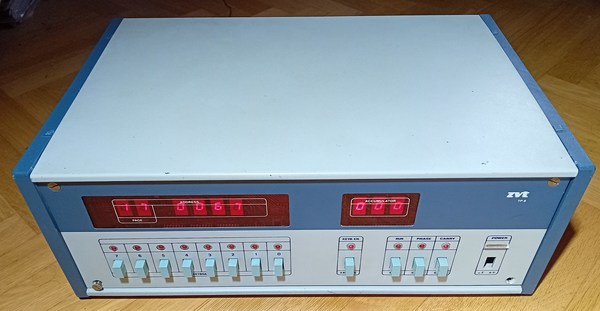ZVT SPU-800
 Also called Systém Pořizování Údajů,TP8.Designed by Ing. Pavel Sedláček.It was manufactured from 1979 (it could have been introduced, the development was definitely taking place) by ZVT B.Bystrica.
Hardware is based on 74181 @ 10 MHz.Operating systems running on the computer: SPUAS,MKOS-1.
Also called Systém Pořizování Údajů,TP8.Designed by Ing. Pavel Sedláček.It was manufactured from 1979 (it could have been introduced, the development was definitely taking place) by ZVT B.Bystrica.
Hardware is based on 74181 @ 10 MHz.Operating systems running on the computer: SPUAS,MKOS-1.
%3Dcarts+processor+TP8%3D%0D%0A%0D%0CACEL%C3%BD+processor+is+built+Na+circuits+%C5%99ady+TTL+74xx%2C+Nen%C3%AD+here++%C5 %Be%C3%A1DN%C3%BD+microprocessor+V+Modern%C3%ADM+words+meaning. CB+006+081+%5D%0D%0A%2A+CAZ+%E2%80%93+%C4%8Dasov%C3%A1+from%C3%A1 Proper+%5B+7CB+006+080+%5D%0D%0A%2A+PRC%E2%80%93+Program BD+%C4%8D%C3%ADTA%C4%8D+%5B+7CB+006+079+%5D%0D%0A%2A+ALJ+%E2%80%93+Arithmetic-Logical+Unit+%5B+7CB+006+082+%5D%0D%0A%2A+ LGP+%E2%80%93+Logic+Pam%C4%9BTi+%5B+7CB+006+083+%5D%0D%0A%0D%0AP%C5%99edn%C3%AD+Panel+Na Marks%C4%8Den%C3%AD+%28%C5%98 %C3%ADD%C3%ADC%C3%AD+Panel%29%2C+to+TP8+SB%C4%9Brnic+is+connected+Help%C3%AD+Individual%C3%BDCH+WEE%C4%8D%C5%AF+%28ov% EN%C3%A9+connections%29.%0D%0A%0D%0avzor+processor+will be+most C3%ad%C5%A1+n%C4%9bjak%C3%A1+Calcula%C4%8Dka+from+HP%2c+estimate+below LE+Terminology+SB%C4%9brnic+-+sign%C3%A1ly+%2FSIh%2C+%2Fceo%2C+SP-SCRATCHPP+can be+Naple%C3%A9ZT+volt%C5%99.+V+HP9830+or+V+PAT ENTU+US4012725A.+%0D%0A%0D%0A%0D%0A%3DEXPAND%C3%A9RY+SB%C4%9Brnic+%3D%0D%0A%0D%0AEXPANDER+-+for%C5%99%C3%Adzen%C3%AD+ur%C4%8 DAY%C3%A9+K+Roz%C5%A1%C3%Ad%C5%99n%C3%AD+Capacity+Opera%C4%8DN%C3%AD+Pam%C4%9Bti+or+Mon C4%8DTU+Peripheral%C3%ADCH+for%C5%99% C3%Adzen%C3%AD+P%C5%99 Connected%C3%BDCH+K+Termin%C3%A1LOV%C3%A9MU+processor+TP+8%2C+If+is+Pot%C5%99eba+P%C5%99 Connect+in%C3%AD CE+NO%C5%Be+4+%C3%A9+Units.+One+Expander+UMO%C5%Be%C5%88 is+Roz%C5%A1%C3%AD%C5%99it+Reint%C3%AD+P%C5%99 connected%C3%AD+ o+dal%C5%A1%C3%ADCH+8+Free%C3%BDCH+Positions.+K+Termin%C3%A1LOV%C3%A9MU+processor+TP+8+is+MO%C5%Ben%C3%A9+P%C5%99%C3%ADMO+P%C5%9 9 connection+and%C5%Be+4+Expand%C3%A9RY.%0D%0A%0D%0AKARTY+Expand%C3%A9RU%3A%0D%0A%0D 0A 2A+TPE+%5B+7CB+006+134+%5D%0D%0A 2A+ETP+%5B+ 7CB+006+135+%5D%0D%0A%0D%0A%0D%0A%3D+Univers%C3%A1LN%C3%AD+Bastl Olem+interconnection%C5%AF+S+metric+spacing%C4%8D%C3%AD+2%2C5mm.+according to+photographs%C3%ad+these+boards+were+from%C5%99%C4%9b+pom%C4%9BRN%C4% 9b+Active%C4%9B+Utoma%C5%Be%C3%ADV%C3%A1NY+NA+R%C5%AFZN%C3%A9+Specific%C3%A9+Application ADT+%C5%BE%C3%A1DNNI+existence%C3%ADC%C3%AD+Peripheral%C3%AD+Plate. Und+%5b+7CB+006+113+%5D%0D%0A%0D%0A%28 is+t%C3%A9%C5%Be+MO%C5%Ben%C3%A9+BUD Name+late%C4%9BJI%29%0D%0A%0D%0A%3DPAM%C4%9btov%C3%A9+cards%3D%0D%0A%0D 0Zapojapojuj%ad+SE+to+ZPP+%C4%8D%C3%A1sti+SPU-800+J AKO+Jin%C3%A9+Peripheral%C3%AD+Cards%0D%0A%0D%0A%2a+P1K+1kB+ROM ++%5B+7CB+006+084+%5D ++ MH74188+%2B3xMH7442+%282x4%2b1%29%0D%0A%% 2a+P4K+SRAM+4KB+%5B+7CB+006+085+%5D%2C ++ 8x4+MHB2102%0D%0A%2A+P16K+SRAM+16KB%2C+32x+MHB2114+%28Nejednalo+SE+O+P%C5 D+in%C3%BDROBEK+ZVT%29%0D%0A%2A+%22EPROM+P%22+S+2x+K573RF5+%28am%C3%A9RSKY+D%C4%9blan 0d%0akarty+can be+address+V+all%C3%A9M+64kB+Address%C3%ADM+space+processor.+At least+one+card+P1K+usually+boot+RO M%2C+Nap%C5%99.+Na+to%C4%8dten%C3%AD+DAL%C5%A1%C3%ADHO+K%C3%B3D+Z+D%C4%9BRN%C3%A9+P%C3%A1SSS+or+SKP 0D%0adle+Available%C3%BDCH+Neov%C4%9b%C5%99n%C3%BDCH+Information%C3%AD+K+SP-800+existed+%C3%A9+Set+card+complete%C3%ADH o+%C5%99adi%C4%8de+s+dram+Pam%C4%9bt%C3%AD+%28carts+PMT+7CB+006+275%2C+GAD+7CB+006+276+A+RSP+7CB+006+277+%29.%0D%0A%0D%0A%3D Peripheral%C3%AD+Cards%3D%0D%0A%0D%0azapojuj%C3%AD+SE+to+ZPP+%C4%8D%C3%A1sti+SPU-800.+UV%C3%A1D%C4%9bn%C3%BD+Select+K%C3% +Standard%C3%AD%2C+V+Eight%C4%8dkov%C3%A9+System%C4%9B+%28Parameter+Instructions+SCO%29.%0D%0A%0D%0A%2A+DPR%3A+Plate+Connected%C 3%ad+%28Pro+%22termin%C3%A1L%22+AZJ+6416%2C+SELECT+K%C3%B3D+013%29+%5B+7CB+006%C2%A0132+%5D%0D%0A 4%8DE+d%C4%9BRN%C3%BDCH+%C5%A1T%C3%ADTK%C5%AF+Arithma+2050+%0D%0A%2A+SDP+%E2%80%93+SN%C3%ADMA%C4%8D+Derne+FS+1501+%5B+7 CB+006%C2%A0087+%5D ++%28SELECT+K%C3%B3D+001%29%0D%0A%2A+DDP+%E2%80%93+d%C4%9brova%C4%8D+Derne+Paskets+DT+105+S+%28 SELECT+K%C3%B 3D+004%29+%5B+7CB+006%C2%A0086+%5D+%0D%0A%2A+KLV+-+PLAVESNICE+CONSUL+259.1+%28SELECT+K%C3%B3D+003%29%0D%0A%2A+MTL+%E2%80%93+ Mosaics%C3%A1+Print%C3%A1RNA+DZM+180+%28SELECT+K%C3%B3D+005%29+%5B+7CB+006%C2%A0088+%5D%0D%0A%2A+MTS+-+with%C3%A9RIOV%C3%A1+Tis K%C3%A1RNA+CONSUL+2111+%0D%0A%2A+HDD+-+for%C5%99%C3%Adzen%C3%AD+PRO+P%C5%99enos+Data+HDD+1200+%28SELECT+K%C3%B3D+009%29%0D%0A% 2a+MPP+Dzc+-+Magnetop%C3%A1Skov%C3%A1+Pam%C4%9B%C5%A5+cm+5300+%5B+7CB+006%C2%A0138+%5D%0D%0A%2A+MPP+DCC+-+Magnetop%C3%A1Skov% C3%A1+PAM%C4%9B%C5%A5+cm+5300+%5B+7CB+006%C2%A0139%3F+%5D%0D%0A 2A+SKP+RKP+-+%C5%98adi%C4%8D+Kassettop%C3%A1Skov%C3% 9BTI+KPP+800 ++%5B+7CB+006%C2%A0226+%5D+%28SELECT+K%C3%B3D+015%29%0D%0A%2A 2A+bath+contains+boards+%C5%99adi%8DE+electronics %3a+%0D%0A%2A%2A%2a+RSK%0D%0A%2A%2A 2A+dep%0D%0A%2A%2A 2A+CRC%0D 0A%2A+DAP+-+plate+Asynchronn%C3%ADHO+P%C5%99enos+%28S+MHB1 012%2C+Neusn%C3%A1+SE+O+in%C3%BDROBEK+ZVT%2C+SELECT+K%C3%B3D+002%29%0D%0A 2A+S2+-+S%C3%A9RIOV%C3%BD+P%C5%99enos+%28MHB1012%29 +%5B+7CB+006%C2%A0233+%5D%0D%0A%2A+%E2%80%9COMUNICKY%C4%8DN%C3%AD+plate+TP8%E2%80%9C+%28UART+MHB8251%2C+RS-232%2 C4%8DKA%2C+IRPS%29%0D%0A%2A+TNS+UVI+-+P%C5%99 connected%C3%AD+print%C3%A1RNY+IRPR+%28SELECT+K%C3%B3D+005%29%0D%0A 2A+DCS+%28Ne+ So%C3%A9+%22DOS%22%29%2C+NENN%C3%A1M%C3%A1+Card%2C+Na+%C4%8Deln%C3%AD+Pages%C4%9B+M%C3%A1+N%C3% %C3%ADNA%C4%8D+LOC%2FDIS.+NO%C3%AD+Necessment%C4%9B+Pat%C5%9it+to+SPU-800. %C4%8C%C3%A1st+Contrary C3%A9MU+SPU+800%2C+UR%C4%8DEN%C3%A1+Pro+Input+or+in%C3%BD retreating+%C4%8D%C3%ADSLICE CH3%BDCH+Information%C3% +V+tubes%C3%A9M+K%C3%B3D+Z+DED%C3%A1len%C3%BDCH+Termin%C3%A1L%C5%AF+HDD+1200+or+file%C5%AF+HDD+1200+PO+Stolt%C3%BDCH+or o+Comutovan%C3%BDCH+phone%C3%ADCH+guided%C3%ADCH+S+High%C3%BDM+degree%C4%9bm+Nemovable%C4%8 days C3%ad %C3%A1M. U+SPU+800%2C+UR%C4%8DEN%C3%A1+Pro+one%C4%9BRN%C3%BD+parallel%C3%AD+P%C5%99enos+Data+Po+Comutovan%C3%A9+S%C3%ADTI+P%C5%99i +Synchronn%C3%ADM+P%C5%99enos+Speed%C3%AD+and%C5%Be+20+character%C5%AF%2FS.+for%C5%99%C3%Adzen%C3%AD+is+appropriate%C3%A9+Pro+ A9MY+SB%C4%9BRU+A+P%C5%99ENOS+Data+Z+in%C3%ADCE+M%C3%ADST+their+up+one+one+P%C5%99IJ%C3%ADMAC%C3%ADHO+Center+%E2%80%9 9 3+M%C3%ADSTA+Processing%C3%A1N%C3%AD+Data. D%0D%0A%C4%8C%C3%A1st+Contrary C3%A9MU+SPU+800%2C+UR%C4%8DEN%C3%A1+Pro+S%C3%A9RIOV%C3%BD+P%C5%99enos+Data+Po+Phone%C3%Adch+or o+telegraphic%c3%adch+guided%c3%adch+speed%C3%ad+from+50+to+1200+bd. D%0ALED+indication%3a%0D%0a%2a+Keyb+E%3a+TP8+V+RE%C5%Beim+back%C3%A1V%C3%A1N%C3%AD+instructions C3%AD+Z+panel%2C+processor+stop EN%0D%0A%2a+Run%3a+processor+B%C4%9b%C5%Be%C3%AD+automatically+Z+Pam%C4%9b%C5%A5ov%C3%A9+SB%C4%9Brnic%0D%0A%2A+Phase%3A+F%C3%A1 of+instructions%2C+sv%C3%ADT%C3%AD+U+type%C3%A9HO+byte+two -backed%C3%BDCH+instructions%C3%AP%0D%0A%2A+Carry%3a+CR+%28carry%29+ FLAG+processor%0D%0A%0D%0function+%28tla%C4%8D%C3%ADTKA%29%3A%0D%0A%2A+Execute Ogram+Counter+SE+does not initiate%29%0D%0a%2a+Run%3a+Lend%C3%AD+processor+Z+Pam%C4%9b%C5OV%C3%A9+SB%C4%9brnic+%28 +back%C3%A1V%C3%A1N%C3%AD+instructions%C3%AD+Z+panel%29%0D%0A%2A+stop%3a+stop%C3%ad Ruction+Z+Pam%C4%9b%C5%A5ov%C3%A9+SB%C4%9Brnic+A+Stop%C3%AD+processor%0D%0A%0D%0ap%C5%99i+B%C4%9BHU+processor Dynamically+program+Counter%2C+ACC%2C+Phase%2C+Carry+%28 Sentes+Boslik%C3%A1VAJ%C3%Ad%29%0D%0A%0D 0A%3D+ZPP+SB%C4%9Brnic+%3D%0D %0A%0D%0ASB%C4%9Brnic+is+V+range+I%2FO+compatible%C3%AD+S+8 -bit%C3%BDMI+TNS. Y+in%0D%0amo%5B0..7%5D+%7c+Memory+Out%0D%0amw+%7C+Memory+Write I%2FO+Status+Out%0D%0asi%5B0..3%5D+%7C+I%2FO+Status+in%0D%0adi%5B0..7%5D+%7c+I%2FO+in%0D%0DO%5B0..7%5D+%7C+I Out%0D%0a%2FSIH+%7C+Service+Inhibit%0D%0A%2FCEO+%7C+Control-enable-output%0D%0A%3C 3E%0A%0D%0A%3D+Modern%C3%BD+in%C3%BDVOJ+% 3D%0D%0a%2a+Bests+replica+processor%C3%BDCH+cards+machines%2C+n%C4%9BKTER%C3%A9+peripheral%C3%ad C+disassemble%0D%0a%2a+n%C3%A1 machine+Na+emulation+d%C4%9BRN%C3%A9+PASSS+%28PRO+SDP%29+P%C5%99es+USB+Port+PC%0D%0A C4%9b%C5%A5ov%C3%A1+Card+%28SPU-MPPK0+-+32kB+Sram+%2b+512kB+Banked%C3%A1+Flash%2C+replaces+P1K+A+P4K ou%C5%Beit%C3%AD+SPU-800+%3D%0D%0A%0D%0A%3D%3D+Termin%C3%A1LOV%C3%A9+Work%C5%A1T%C4%9B+%3D%3D%0D 5%beit%C3%AD+SPU-800+NA+%C4%8CVUT+FEL+SE+below%C4%9BLIL+V+year+2023+Martin+B%C3%ADL%C3%BD%3A+%22o+I knew+as+%C5%99 %9BME+POU%C4%8DEN%C3%BD+U%C5%Be user+n%C4%9bkKs+around+year+1985.+I met+SE+S+T%C3%ADM+V+RE%C5%Beim+%C5%99 Ermin%C3%A1LOV%C3%A9HO+Work%C5%A1T%C4%9b.+%C4%8Ts C5%99i+Workshop%C3%AD+M%C3%ADSTA%2C+character%C3%A1+screen%2C+KL%C3%A1V ESICE.+Prost%C5%99ednative%C3%ADM+domestic%C3%BDCH+modem%C5%AF+P%C5%99 connected+spollers%C4%8 days+fixed+line+K+over%C5%99azen%C3 %A9MU+Mon%C4%8D%C3%ADTA%C4%8Di.+Modems+Sizes+Box+from+Bot%2C+from%C5%99%C4%9B+%C5%A1LO+O+MDS+1200.+NA+T%C3%A9+Line+was +n%C4%9bjak%C3%BD+Protocol+Pro+Addressing+Individual%C3%BDCH+Work%C5%A1%C5%A5. ATN%C4%9B+TU%C5%A1%C3%Adm%2C+%C5%Bee+SE+P%C5%99%C3%A1%C5%A1el+Text+All C3%A9HO+%C5%99%C3%A1DKA+A+%C5%Bee+%C5%99%C3%A1Dky+N A+screen+scrolled.+NO+n%C4%9BCO+as+addressing+cursor.+%C5%Bee+such%C3%BD+SP%C3%AD%C5%A1+D%C3%A1LNISN%C3%B D+RE%C5%Beim.+Pro+editing+File%C5%AF+V+%C5%99%C3%A1DKOV%C3%A9M+Re%C5%Beim+to+Power+Comfort 9+delays+p%C5%99i+p%C5%99EP%C3%ADN%C3%A1N%C3%ADM+MODEM%C5%AF+between+P%C5%99%C3%ADMM+A+VIHT%C3%ADL%C3%A1N%C3%ADM+V+ SD+SD%C3%Adlen%C3%ADM+slow%C3%A9+SD%C3%Adlen%C3%A9+Lines+Zp%C5%Afsobil%2C+%C5%Bee+to+U%C5%Bike VALI+SP%C3%AD%C5%A1E+only+V+NEPE%2C+When+Neek%C4%9bli+%C4%8DEKat+Na+Release%C4%9bn%C3%AD+%22norm%C3%A1LN%C3%ADCH%22+Termin%C3% A1l%C5%AF. 5%Be user%C3%BDCH+Work%C5%A1%C5%A5+MiniPo%C4%8D%C3%ADTA%C4%8DE+ICL-2904.+Communications 2c+modems+for+both+ends+were+above+on+V+table+one+Z+t%C4%9BCH+work%C5%A1%C5%A5.+Nev%C3%ADM+for%C4%8D+there+ C5%Beity+Modems.+MO%C5%Ben%C3%A1+TEN+Mon C4%8D%C3%ADTA HO+A+SKUT%C4%8DN%C3%A9HO+Service%C3%A9HO+interface%C3%ad+SE+in%C5%A1MI+%C5%99%C3%Addic%C3%ADMI+sign%C3%A1ly+A+their+%C4% In%C3%BDMI+PR%C5%AFB%C4%9Bhy.%0D%0A%0D%0anm%C3%A1M+At least%C5%A1%C3%AD+TU%C5%A1EN Beit%C3%AD+SPU-800%2C+How+A+V+%C4%8DM+SE+TO+V+V+Tom+M%C3%A9M+P%C5%99%C3%ADPad%C4%9B+TA+assembly+Na+ YSSP%C3%A9+OTO%C4%8DEN%C3%AD+S%C3%AD%C5%A5ov%C3%BDM+out%C3%ADNA%C4%8DEM. Ad+k+history+use%C5%Be%C3%ADV%C3%A1N%C3%AD+in%C3%BDPO%C4%8Detn%C3%AD+Techniques+Na+FE+BUT+Brn%C4%9B+UV%C3%A1D%C3%AD+K+SP-80 0%3a+%22 -Prvn%C3%AD+Termin%C3%A1l+U%C4%8Deb+was+U%C4%8Debna+built%C3%A1+Na+BY C3%A9MU+SPU+800 ...+Termin%C3%A1LOV %C3%A1+U%C4%8Debna+was+P%C5%99 connected+K+minipo%C4%8D%C3%ADTA%C4%8DI+ADT+4316+P%C5%99es+with%C3%A9RIOV%C3%BD+Communications C4%8Dn%C3 %AD+protocol+TC-99%2C+its%C3%AD+use%C5%Be%C3%ADV%C3%A1N%C3%AD+was+ZH%C3%A1Jeno+V+year+1983.+systems C3%A9M+SPU+800+SES Al+Z+Termin%C3%A1LLOV%C3%A9HO+processor+TP8%2C+9+Expander%C5%AF%2C+Jimi%C5%Be+was+MO%C5%Ben%C3%A9+habit %C5%99 connected%C3%BDCH+for%C5%99%C3%Adzen%C3%AD+A+Individual%C3%BDCH+Work%C5%A1%C5%A5.+V+to%C5%A1%C3%AD+Termin%C3%A1LOV%C3%A9+ U%C4%8Debn%C4%9b+were+t%C4%9bmito+for%C5%99%C3%Adzen%C3%ADMI+alphanumeric%C3%A9+display%C3%AD+units+azj+6416+ %C4%9bn%C3%A9+also%C4%9b%C5%Be+V+Zvt+Bansk%C3%A1+Bystrica+%5b ... +in%C3%BDVoji+Termin%C3%A1LOV%C3%A9+U%C4%8Debny+SE+V+TU+Time+Typical%C3%BD+Rys+%E2%80%93+to%C5%A1E+Work%C5%A1T%C4% 9b+had to+own%C3%admi+forces+develop+pot%C5%99bn%C3%A9+Technical%C3%A9+A+Program%C3%A9+Equipped%C3%Ad. DY+SE+NA+market+discovered+for%C5%99%C3%Adzen%C3%AD%2C+their%C5%Be+deployed%C3%AD+to+KPR%C3%A9TN%C3%AD+Application+Si+%C5%99E %A1II+their+U%C5%bells%C3%A9+Sama.+On%C5%A1E+work%C5%A1T%C4%9b+was+such%C3%A9+%C4%8Ds+capable%C3%A9+realize . 0A%0D%0A%3C%3E%0AJI%C5%99%C3%AD+Bruno+Zadom%C3%ADNAL %28ZPA+6000%2F20%29+Z+Magnetick%C3%A9+8+STOP%C3%A9+P%C3%A1SSKY%2C+which%C3%A1+was+in%C3%BD+%C3%BALOHY+large%C3%A9+MA%C5 %A1iny+EC+1021+%28zPa+6000%2F20%29.+OPER%C3%A1to%C5%99i+deployed+P%C3%A1SKO+to+IZOT-5300+P%C5%99 connected%C3%A9+K+SP800%2C+d%C 3%A1le+K+Tu+SPU800+was+P%C5%99 connected+I+large%C3%A1+print%C3%A1RNA+EC7034+from+EC1021.+ZAT%C3%ADMCO+EC1021+U%C5%Be+worked+N A+DAL%C5%A1%C3%AD+%C3%Balloze%2C+SPU-800+PRID+in%C3%BD Supremes+Z+Great%C3%A9+MA%C5%A1IN+Z+P%C5%99ed%C3%ADHO+Job.+to+SEG RAM+DO+TO+SPU+REPUS%C3%A1VAT%2C+M%C4%9BLI+we are+there+return%C5%Bene+EPROM+card. %C3%A1N%C3%AD+%C3%Badaj%C5%AF+%3D%3D%0D%0A%0D%0A%3D%3D+OVL%C3%A1DAC%C3%AD+Mon C4%8D%C3%ADTA%C4%8D+%3D% %A1or+Prom+A+EPROM+%28Viz+AMARO+V+Reference%C3%ADCH%29%0D%0A%0D%0A%3D%3D+%C5%98%C3%Adzen%C3%AD+Technologic%C3%BDCH+Process%C 5%AF+%3D%3D%0D%0A%0D%0A%3D%3D+Mon%C5%99izov%C3%A1n%C3%AD+Data+%3D%3D 0D%0A%0D%0A%3C oukrom%C3%A9+correspondence+%282024%2F05%29+K+POU%C5%Beit%C3%AD+SPU-800%3A%0D%0A%0D 0A%22zauj%C3%ADMav%C3%A9+SPU-80 0+Bolo+V+%C5%BDIARI+NAD+HRONOM+V+Hlinik%C3%A1Rni%2C+Where+Bola+SIE%C5%A5+SP-800+%28mo C5%Beno+AJ+10+pcs 29+connected%C3%A1+K+SM +4-20+A+SPU-800+Boli+connected%C3%A9+NA+Furnace+Na+in%C3%BDROB+alumin -EFECT+%E2%80%93+ELECTION+ELECTION C3%B3DY+Z+liquid%C3%A9ho+alumin A.+below%C4%Bea+of this+Mali+Operation+Reverence.+Na+for%C4%8Datuk+to+Hard+turned out%2C+Lebo+Operator+did not respond%2C+%C4%8DO+SP%C3%B4SO Bala+in%C4%Bemi+in%C4%back%C3%A9+Energy%C3%A9+Stratty.+K%C3%BDM+SI+NA+TO+used%2C+Doch% %C3%BDPO%C4%8dtov+techniques ...%22%0D%0A%3C%3E%0A%0D%0A%3D%3D+Mon%C4%8D%C3%Adta TO+M%C5%AF%C5%Bee+Zn%C3%ADT+Divn%C4%9b%2C+Na+SP-800+I+I+Mon C4%8D%C3%ADTA 2astreel+Na+Movement+Cil%2A%2A%2c+V+which%C3%A9+are+these+instructions%3A%0D%0A%0D%0A%3C%0JSI+deck TR%C3%A1%C5%Ben%C3%AD+TRAN%C5%Beice.+M%C3%A1%C5%A1+K+Available+Laser%C3%A9+D%C4%9blo+A+Energy%C3%BD+Source+Na+10+in%C3%BD Ste%C5%99el%C5%AF.+Your+%C3%Baloh+Po+Decment C3%A1%C5%A1EN%C3%AD+Alarm+is+Definitions C4%8Dit+Ste%C5%99el ER%C3%A9+SE+Gradually%C4%9b+Discover%C3%AD+V+First%C3%ADM+%C5%99%C3%A1DKu+Screens+A+Move%C3%AD+SE+ZVA+Transport.+D%C4%9blo+J E+UM%C3%ADST%C4%9BNO+NA+Last%C3%ADM+%C5%99%C3%A1DKu+right.+Firing+SE+KL%C3%A1ves+%220%22.+according to+SV%C3%BDCH+ability %C3%AD+Si+Choam+speed+C%C3%ADLE%3A+1+-+cosmick%C3%BD+green%C3%A1%C4%8D%2C+2+-+PR%C5%AFM%C4%9BRN%C3%BD+pilot%2C+3+-+Star%C3% BD+MACHR.+%0D%0A%3C%3E%0A%0D%0Tatato+Game+I+I+for+8 -bit%C3%A9+Mon C4%8D%C3%Adta %0a%3D+interconnected%C3%ad+s+DAL%C5%A1%C3%ADMI+system%C3%A9MY+%3D%0D%0A%0D 0A exist+program+LPT2SPU+UMO%C5%Be%C5%88uj%C3%ADC%C3%A
Inaccuracies/doubts related to the topic
Unknown predecessor - "inspirational model" (probably from Hewlett-Packard)
If you have information on the ''Unknown Derived Computers'' chapter.
Insecure controller with DRAM memory.
If anyone has more information, please get in touch.
Computers derived from ZVT SPU-800
The following computers were inspired by or derived from ZVT SPU-800:References
- https://cs.wikipedia.org/wiki/ZVT_SPU-800 (WebArchive)
- Terminálový procesor TP 8, technický popis. ZVT k.p. Banská bystrica
- Terminálový procesor TP 8, prehľad ďalšieho programového vybavenia, ZVT k.p. Banská bystrica, 1980
- Terminálový procesor TP 8, malý kazetopáskový operačný systém MKOS-1, ZVT k.p. Banská bystrica, 1981
- Sedláček, Pavel: Základy programování mikropočítače TP-8
- 4. seminární školení k využití výpočetní techniky-sborník přednášek. Dil 1
- 4. seminární školení k využití výpočetní techniky-sborník programových rutin SPU-800
- 5. seminární školení k využití výpočetní techniky : Sborník přednášek
- 6. seminární školení k využití výpočetní techniky-OS SPUAS - Systémové a aplikační programy
- Klvaňa M. 1983 , MONEX - jednoduchý uživatelský program pro spolupráci periferií systému SPU 800 s pamětí procesoru TP8, R: Konference "Možnosti využití zařízení SPU 800", ČSVTS Praha, 1983, V: Publikace "Možnosti využití zařízení SPU 800", ČSVTS KORT Ostrava, (1983), 72-75
- https://apps.dtic.mil/sti/tr/pdf/ADA342651.pdf (WebArchive)
- https://apps.dtic.mil/sti/tr/pdf/ADA342661.pdf (WebArchive)
- https://apps.dtic.mil/sti/tr/pdf/ADA359734.pdf (WebArchive)
- http://prog-story.technicalmuseum.cz/data/vut-fit/vyuzivani-vt.pdf (WebArchive)
- https://patentimages.storage.googleapis.com/a0/8c/82/0f7a60dfc96264/CS232023B1.pdf (WebArchive)
- čs. patent PV 1978-767
- Sdělovací technika: měsíčník pro rozvoj a praxi sdělovací elektrotechniky. Praha: Státní nakladatelství technické literatury, 05.1983, 31(5), s. 167. ISSN 0036-9942. Dostupné také z: https://ndk.cz/uuid/uuid:82425d00-6785-11ea-8fc0-005056825209
- Sdělovací technika: měsíčník pro rozvoj a praxi sdělovací elektrotechniky. Praha: Státní nakladatelství technické literatury, 12.1984, 32(12), s. 451. ISSN 0036-9942. Dostupné také z: https://ndk.cz/uuid/uuid:c2efdd70-6373-11ea-8fc0-005056825209